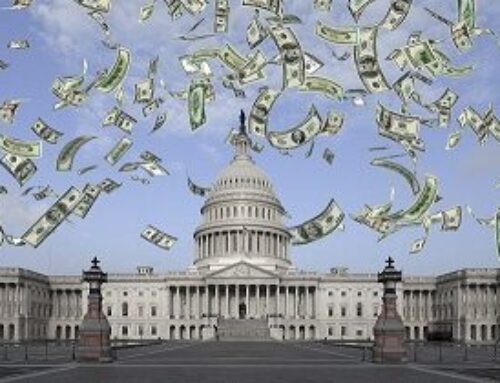I’ve written about tax reform many times in this space – often about the politics, the need for meaningful reform to be bipartisan, and just how difficult the work of crafting comprehensive reform will be.
Now, if Republican leadership is to be believed, it appears that we have reached a point where tax reform might actually be not on the horizon, but in the near future. The Senate and the House have adopted a budget resolution including reconciliation instructions that enable a simple majority to adopt tax proposals, which means that tax reform could be passed on purely party line votes. And while we have seen how difficult it can be to achieve agreement within the majority party, this truly is the closest the country has been to a major tax package in decades.
Without going into detail about what the package might look like (particularly because we have very few details to parse), now seems like a good moment to step back and think about the policy underlying our tax system.
Tax policy is complicated because it needs to achieve multiple goals, some of which conflict, requiring policymakers to make tradeoffs. No tax policy is ideal for all times and circumstances, but successful tax policy optimizes tradeoffs in a way that is acceptable to most taxpayers. Of course, there are many, many different approaches to tax policy and reforming our tax code. But all tax policy should revolve around four essential values and needs: revenue, efficiency, equity and effectiveness.
Raising revenue is the first requirement of any tax system, and the amount of revenue to be raised should always be considered relative to expenditures. If expenditures exceed revenues the government runs a deficit, which is covered by issuing debt. (This has happened in all but 13 years since 1930.) If revenues exceed expenditures, the government runs a surplus, and unless the surplus comes from Social Security or other retirement funds, the surplus reduces the national debt. My organization, Taxpayers for Common Sense, has never demanded that the budget be balanced and revenues equal or exceed expenditures in all years, simply because economic circumstances matter. Whether running a deficit is good or bad policy depends primarily on the size of the deficit, the size of the national debt relative to the economy, and the state of the economy. But in our entire 23-year history, Taxpayers for Common Sense has kept a close eye on the deficit. Right now, the national debt is larger (relative to the economy) than at any time since immediately after World War II and it is expected to grow even without a tax cut.
The concept of economic efficiency in tax policy – when taxes have the least distortionary effect possible – is more complicated than the idea that we should balance revenue and spending. Broadly speaking, taxes change prices – companies include the taxes they pay in the prices they charge, and the price of your labor is affected by how much income tax you must pay. That difference in price, in turn, distorts market decisions, leading to a misallocation of resources that in turn reduces economic growth and prosperity. A broad tax base helps minimize economic distortions, because a broad base makes it possible to raise necessary revenue with lower tax rates. Lower rates create a smaller wedge between before-tax and after-tax prices.
Efficient taxation alone cannot promote economic growth; government expenditures, other policies, and innovation also play pivotal roles. But an inefficient tax system is a major barrier to healthy economic growth. And even in today’s polarized Washington, we can all agree the current tax code – riddled with special interest tax breaks and dated provisions that ignore the innovation and changes of the last several decades – is not a model of efficiency.
We must also recognize that there are some cases where before-tax prices do not reflect total economic costs or benefits (e.g., the cost of pollution from fuel burning, or the reduction in road congestion from mass transit). These are products or services that have “market externalities.” In these cases, increasing a tax to cover a cost (e.g. pollution) or decreasing a tax or adding a subsidy to promote a benefit (e.g. mass transit) achieves better allocation of economic resources and therefore more economic growth and prosperity. There are some products and services with huge market externalities (e.g. products that generate various kinds of pollution) and taxing them correctly improves the economy.
Equity, the next value or goal of all tax policy, is in many ways the most obvious. But in today’s debates, the idea of tax equity often produces the greatest controversies, in part because of the many different ways the word “equity” itself is used. What economists mean when they discuss equity is how tax burdens are distributed among taxpayers, which is just as important as how much revenue is collected. There are two types of equity in the context of tax policy: horizontal and vertical. Horizontal equity requires that taxpayers with the same amount of taxable income (or wealth or consumption or property) pay the same tax. If two people make the same amount of money, they pay the same taxes. Houses in the same town with the same assessment pay the same property tax. Although this is generally not controversial in principle, there are examples in the current federal system where the tax system provides unequal treatment for essentially similar taxpayers.
Vertical equity addresses fairness across taxpayers with different incomes (or levels of wealth). The personal income tax system is based on the principle that richer people should pay tax at a higher rate than poorer people, which is the definition of a progressive tax. But this is not always the case, and that can make taxpayers frustrated and angry. Think of Warren Buffet pointing out that he pays a lower tax rate than his secretary, because of the exclusions and deductions available to him that are not available to his secretary, whose income comes almost exclusively from wages. And even after eliminating unfair exclusions and deductions, there is still the essential question of what rate should be applied to high-income earners and what rate applied to low-income earners.
Tax equity must be examined in terms of who bears the burden of a tax, not who pays a tax. This goes back to the idea that taxes change prices. Businesses pay tax, but the taxes that they pay are always shifted to some combination of business owners, workers, customers and suppliers, who then shift those taxes to their owners and workers, and so on.
The final goal – effectiveness – is one everyone can agree on. All tax systems should be effective in the sense that the system should make it difficult to cheat outright or use gamesmanship to avoid paying tax owed. Tax evasion, or cheating, is by definition illegal, but some tax policies make it easier to cheat than others, so reducing tax cheats is about more than enforcing current laws. Tax avoidance or legal gamesmanship that twists laws into pretzel shape to avoid paying taxes or reduce taxes is legal. So tax policies should be designed to make it difficult to bend laws into pretzels. The more taxes people and companies can evade and avoid, the lower the revenues – and the more other taxpayers need to pick up the slack. And that makes honest taxpayers distrust the tax system and feel (correctly) that the system is unfair.
Designing a tax system to minimize evasion and avoidance imposes administrative costs on government and compliance costs on taxpayers. The goal is to balance administrative and compliance costs against the rewards of higher revenue collection and higher confidence in the system. In general, simpler is better, but many tax problems are highly complex, and call for complex solutions. Paraphrasing Einstein, tax law and administration should be as simple as possible, but no simpler.
So how can today’s Congress balance all of these considerations? What set of policy choices would meet all of these goals at once – generate enough revenue to pay for the government that taxpayers demand, minimize economic distortions, correctly tax market externalities, treat taxpayers fairly, and make it difficult for taxpayers to evade or avoid taxes? There is no one right answer, but there are a lot of wrong answers. These critically important principles point back to some issues I’ve raised in past columns. These are hard choices, choices that should be made through deliberate, bipartisan engagement.
If you made it all the way through this long column, you might be disappointed that I’ve come back to themes I’ve written about so often. But the rush to take advantage of the simple majority vote enabled by reconciliation poses a real risk to achieving meaningful tax reform. The complexities of balancing these simple but important goals – revenue generation, efficiency, equity and effectiveness – demand a better process.
We can’t afford to explode the deficit and mask it with time-limited budget gimmicks. We can’t afford to needlessly increase our already enormous national debt. We can’t afford to throw away the opportunity presented by the universal agreement that our tax code is broken by changing it with a divisive process that limits policy options. I’ve said it before and I’ll say it again: Congress needs to roll up its sleeves, look across the aisle and get serious about reforming our tax code.











Get Social